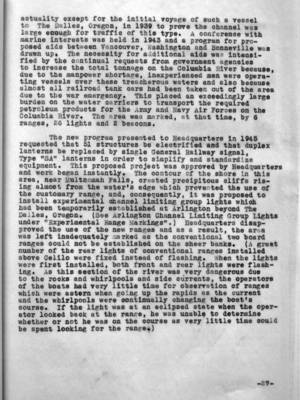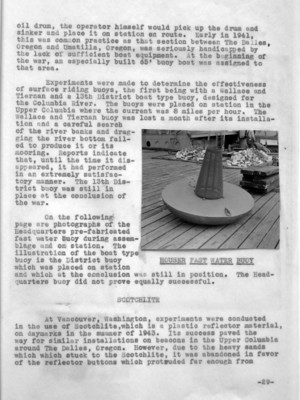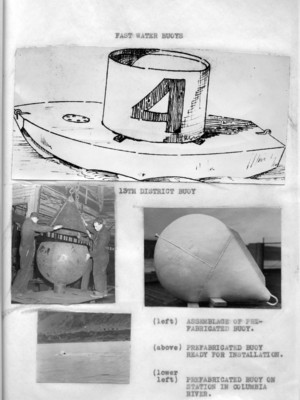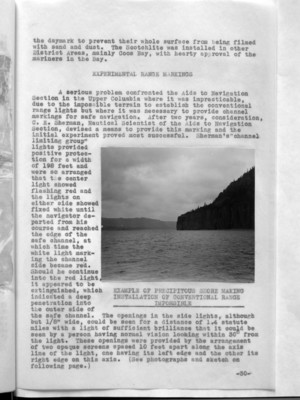Pages
46
actuality except for the initial voyage of such a vessel to The Dalles, Oregon, in 1939 to prove the channel was large enough for traffic of this type. A conference with marine interests was held in 1943 and a program for proposed aids between Vancouver, Washington and Bonneville was drawn up. The necessity for additional aids was intensified by the continual requests from government agencies to increase the total tonnage on the Columbia River because, due to the manpower shortage, inexperienced men were operating vessels over these treacherous waters and also because almost all railroad tank cars had been taken out of the area due to the war emergency. This placed an exceedingly large burden on the water carriers to transport the required petroleum products for the Army and Navy Air Forces on the Columbia River. The area was marked, at that time, by 6 ranges, 26 lights and 2 beacons.
The new program presented to Headquarters in 1945 requested that 51 structures be electrified and that duplex lanterns be replaced by single General Railway signal, Type "SA" lanterns in order to simplify and standardize equipment. This proposed project was approved by Headquarters and work began instantly. The contour of the shore in this area, near Multnomah Falls, created precipitous cliffs rising almost from the water's edge which prevented the use of the customary range, and, consequently, it was proposed to install experimental channel limiting group lights which had been temporarily established at Arlington beyond The Dalles, Oregon. (See Arlington Channel Limiting Group Lights under "Experimental Range Markings".) Headquarters disapproved the use of the new ranges and as a result, the area was left inadequately marked as the conventional two board ranges could not be established on the sheer banks. (A great number of the rear lights of conventional ranges installed above Celilo were fixed instead of flashing. When the lights were first installed, both front and rear lights were flashing. As this section of the river was very dangerous due to the rocks and whirlpools and side currents, the operators of the boats had very little time for observation of ranges which were astern when going up the rapids as the current and the whirlpools were continually changing the boat's course. If the light was at an eclipsed state when the operator looked back at the range, he was unable to determine whether or not he was on the course as very little time could be spent looking for the range.)
-27-
47
(picture)
THE PICTURE SHOWS AN INLAND NAVIGATION CO. BARGE ST(R)ANDED IN THE CELILO RAPIDS, GIVES AN IDEA OF THE DIFFICULT CHANNELS, THE SWIFT AND SHALLOW WATER, AND THE GENERAL TERRAIN WITH WHICH NAVIGATORS IN THIS VICINITY MUST COPY. THE BARGE HAD BROKEN LOOSE FROM ITS MOORINGS AND DRIFTED TO THIS PRECARIOUS POSITION. IT WAS FLOATED BY THE RELEASE OF A HEAD OF WATER FROM COULEE DAM WHICH TOOK 2 TO 3 DAYS TO REACH THE AREA. RESCUE WAS CONDUCTED BY CABLES BETWEEN MEN ON THE BARGE AND THE SHORE AS POWER BOATS WERE NOT ABLE TO ENTER THE RIVER AT THIS POINT. THE NAVIGATION CO. REALIZED CONSIDERABLE LOSS IN THIS PARTICULAR CASE ALTHOUGH INSTANCES OF THIS TYPE ARE NOT UNCOMMON IN RIVER TRAFFIC. THIS BARGE IS TYPICAL OF THOSE FOUND IN THE COLUMBIA RIVER AREA.
EXPERIMENTAL BUOYS
The area between Bonneville, Oregon, and The Dalles, Oregon, consisted of two deep water pools which were formed by the construction of the Bonneville Dam and was well lighted with numerous river bank lights. a meeting with vessel operators a few months before the war resulted in the unanimous approval of the lights as they were at that time. Requests were constantly made for installation of buoys but none were developed which could ride the swift current during freshets. Oil drum buoys were set out in the vicinity of Celilo and, at the conclusion of the war, were still the most effective buoy markings. The buoys had been painted white, with red or black band markings as the navigators had found it difficult to pick out the solid red or black buoys at night. The mariners urged the development of a surface riding buoy equipped with reflectors as reflectors could not be installed on the oil drums. The dependency of tugboat operators on these markings was evidenced in the fact that if the tender assigned to that area was unable to replace an
_28-
48
oil drum, the operator himself would pick up the drum and sinker and place it on station en route. Early in 1941, this was common practice as that section between The Dalles, Oregon and Umatilla, Oregon, was seriously handicapped by the lack of sufficient boat equipment. At the beginning of the war, an especially built 65' buoy boat was assigned to that area.
Experiments were made to determine the effectiveness of surface riding buoys, the first being with a Wallace and Tiernan and a 13th District boat type buoy, designed for the Columbia River. The buoys were placed on station in the Upper Columbia where the current was 8 miles per hour. The Wallace and Tiernan buoy was lost a month after its installation and a careful search of the river banks and dragging the river bottom failed to produce it or its mooring. Reports indicate that, until the time it disappeared, it had performed in an extremely satisfactory manner. The 13th District buoy was still in place at the conclusion of the war.
On the following page are photographs of the Headquarters pre-fabricated fast water buoy during assemblage and on station. The illustration of the boat type buoy is the District buoy which was placed on station and which at the conclusion was still in position. The Headquarters buoy did not prove equally successful.
(image) HOUSER FAST WATER BUOY
At Vancouver, Washington, Experiments were conducted in the use of Scotchlite, which is a plastic reflector material, on daymarks in the summer of 1943. Its success paved the way for similar installations on beacons in the Upper Columbia around The Dalles, Oregon. However, due to the heavy sands which stuck to the Scotchlite, it was abandoned in favor of the reflector buttons which protruded far enough from
-29-
50
the daymark to prevent their whole surface from being filmed with sand and dust. The Scotchlite was installed in other District Areas, mainly Coos Bay, with hearty approval of the mariners in the Bay.
A serious problem confronted the Aids to Navigation Section in the Upper Columbia where it was impracticable, due to the impossible terrain to establish the conventional range lights but where it was necessary to provide channel markings for safe navigation. After two years, consideration, C. E. Sherman, Nautical Scientist of the Aids to Navigation Section, devised a means to provide this marking and the initial experiment proved most successful. Sherman's "channel limiting group" lights provided positive protection for a width of 198 feet and were so arranged that the center light showed flashing red and the lights on either side showed fixed white until the navigator departed from his course and reached the edge of the safe channel, at which time the white light marking the channel side became red. Should he continue into the red light, it appeared to be extinguished, which indicated a deep penetration into the outer side of the safe channel. The openings in the side lights, although but 1/8" wide, could be seen for a distance of 1.4 statute miles with a light of sufficient brilliance that it could be seen by a person having normal vision looking within 30° from the light. These openings were provided by the arrangement of two opaque screens spaced 10 feet apart along the axis line of the light, one having its left edge and the other its right edge on this axis. (See photographs and sketch on following page.)
(image) EXAMPLE OF PRECIPITOUS SHORE MAKING INSTALLATION OF CONVENTIONAL RANGE IMPOSSIBLE
-30-




